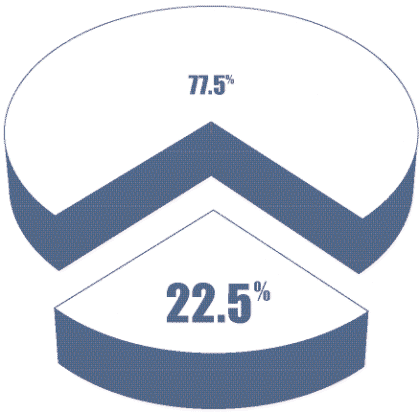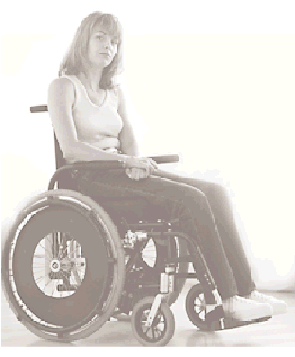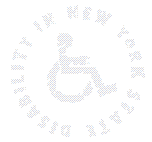Disability in New York State


In New York State, about one in five of the adult,
non-institiutionalized population (about 3 million people)
report an activity limitation.
New York State Department of Health

What is Disability?
There are considerable challenges in trying to measure the extent of disability in a population. This is due largely to the lack of a common definition of disability. State and national estimates tend to vary depending on the definition and survey tool used. For example, some data are gleaned from the self-reported need for help in performing basic self-care activities. Other estimates are based on the number of individuals served by various agency programs which can further differ by eligibility criteria.
This document defines disability among adult New Yorkers based primarily on responses to a single item on the New York State Behavioral Risk Factor Surveillance System (BRFSS) survey : "Are you limited in any way in any activities due to a chronic health problem or condition?" Two subgroups reflect the degree of disability: 1) limited, but require no help with basic self-care activities; and 2) limited, and require help with either routine or personal care needs. Based on responses to the survey, about one in five adult New Yorkers (over 3 million people) reported having a disability due to an impairment or health condition. The prevalence of disability varied substantially among certain demographic subgroups. For example, the prevalence increased with age (Figure 1).
Female respondents were slightly more likely to report having a disability than males (Figure 2). Furthermore, the prevalence of disability tended to be greater among less-educated subgroups (Figure 3). Among racial/ethnic subgroups, no substantial differences in disability prevalence were found for white/non-Hispanics, black/non-Hispanics, and Hispanics (Figure 4). The lower prevalence of disability noted in the "other" category (19.2%) is primarily due to lower reported limitation among Asians and Pacific Islanders, who comprised about 70% of this subgroup.
Disability As A Public Health Concern
Disability often results in a reduced quality of life, compromised health status and increased interactions with the health care system. More people than ever are living into their older years, frequently with accompanying disability. People who develop or incur a disabling condition or injury early in life, are living longer thanks to medical advances. However, they are at risk for the same chronic health problems (e.g., heart disease, obesity, and osteoporosis) as individuals without disabilities, but often at a much earlier age. It is important for public health to assume a leadership role in several areas:
1) extending health promotion and protective practices to these populations;
2) assessing the impact of disability; and
3) identifying preventable disability-related health conditions (i.e., secondary conditions).
Health promotion and protective practices such as physical activity and smoking cessation are encouraged for the general population. They are probably more important for people with disabilities who often experience what is termed a thinner margin of health.
Approximately 6% of adult New Yorkers reported on the 2000 BRFSS survey that they required assistance with basic self-care activities. Of this total, about half (53.8%) reported no recent leisure-time physical activity (Figure 5), almost twice the total for the population without any limitation in activity.
Lack of participation in leisure-time physical activity among persons with disabilities may be linked to barriers they encounter, including societal attitudes, physical access, the lack of transportation and the lack of knowledge about how to adapt general programming to meet the needs of people with disabilities. Additionally, health professionals often may not recommend physical activity to their clients with disabilities, because they may underestimate the abilities of their patients. They also may not be aware of the benefits that people with disabilities can accrue through increased physical activity.
The 2000 survey data indicated that adults with disabilities were generally more likely to be current smokers than were those without any reported activity limitation (Figure 6). In particular, the prevalence of current smoking behavior among working-age (18-64 years) persons with disabilities who also require assistance with basic self-care activities was nearly 50% greater than that among individuals without disability (37% versus 24%, respectively).
Public health practitioners must utilize their expertise in reducing high risk health behaviors in ways that are inclusive of persons with disabilities. Individuals with disabilities need to see that they are among the audience being addressed, both through generic public health campaigns and in specific campaigns designed to meet their particular health risk reduction needs.
Note: BRFSS stands for Behavioral Risk Factor Surveillance System, a telephone survey of adult New Yorkers. The combined 1998-2000 BRFSS is the data source for all figures.
Health Care
Disability is often equated with poor health status, and the health needs of people with disabilities are often considered only in relation to their disability. The management of the primary disabling condition becomes the overriding concern, with less attention paid to the generally recommended standards of health screening and disease prevention. Based on the 2000 BRFSS survey data, persons with disabilities were more likely to self-report their general health status as "fair" or "poor" than were those without disability, regardless of age (Figure 7). Moreover, the greater the degree of limitation, the greater the proportion of those reporting fair or poor health. This same response pattern among the subgroups was found for the health status measure of more than 15 days of poor physical health in the last 30 (Figure 8).
Few health care providers include preventive health counseling or screening for individuals with disabilities. The 1997 Healthy People 2000 Progress Review reported that only 12% of people with disabilities received the screening, immunization and counseling services appropriate for their age and gender as recommended by the U.S. Preventive Health Task Force. Lack of attention to preventive health care for people with disabilities increases their risk of developing the same chronic conditions as the general population, often at a much earlier age. For example, a woman who has been a primary wheelchair user since birth is at a much greater risk of developing osteoporosis at an earlier age because of the lack of weight-bearing activities.
To receive primary preventive health services and counseling in addition to specialty care, individuals with disabilities should have both a primary care provider and a specialist.
The specialist should be knowledgeable about the particular disabling conditions. The specialist should also play a role in the overall management of the disabilities and in the prevention of secondary conditions. (Secondary conditions are those additional health problems individuals with disabilities experience that are related to their disability.) For example, an individual with spinal cord injury should be monitored by a urologist to prevent urinary tract infection which, if not identified early and treated, can cause rampant infection and hospitalization. However, specialists are often not trained in providing certain primary preventive services, such as routine screening tests and generic health promotion counseling, that can detect or prevent certain chronic health problems. Primary care providers do offer such services and can thus round out the full range of health care needed by persons with disabilities.
Access to both adequate primary health care and specialty health care is critically important for individuals with disabilities, whose quality of life and ability to live independently may rely on their ability to maintain their health. However, in 1996, 23% of BRFSS respondents between the ages of 18 and 64 with disabilities significant enough to require assistance with self-care activities rated their health care as fair or poor as compared to 11% of respondents with no limitation in activity. This gap may be reduced through increased access to primary preventive health services and counseling.
Surveillance and Epidemiology
While data such as those collected by the BRFSS have increased our knowledge of the burden of disability, much still needs to be done to standardize a definition of disability, and to include questions related to health and disability on state and national survey instruments. Addressing these challenges in health surveillance systems will give public health agencies the opportunity to identify and track the health status, interactions with the health care system, and frequent medical conditions experienced by persons with disability and chronic disease. Improved surveillance data will prompt earlier identification, treatment, and the application of community-based interventions to prevent further disability or secondary conditions. This will, in turn, improve quality of life and reduce health care costs for this population.
 |
| Health promotion and protective practices such as physical activity and smoking cessation are encouraged for the general population. They are probably more important for people with disabilities who often experience what is termed a thinner margin of health. |
Public Health Strategies
Public health practitioners can apply existing public health strategies to improve health and wellness for persons with disabilities. Innovative programs are being developed and validated to address many of the issues discussed here. The following are a few examples of health promotion strategies which can be more widely incorporated into public health practice.
Health Promotion
The New York State Department of Health is promoting a promising health promotion intervention titled, Living Well with a Disability.
This eight-week peer-led workshop series targets health promotion and the prevention and management of secondary conditions. Preliminary evaluation of the results of the workshop series indicates that individuals who participated in the workshop experienced a decrease in disability due to secondary conditions six months after the workshop. Additionally, these same individuals reported a 45% decrease in physician visits during the same time period. Among New York State participants, Medicare expenditures were $2,113 per person for the two months prior to the intervention and $1,112 during a similar time period two months after the intervention.
Nationally, the Centers for Disease Control and Prevention (CDC) have funded the National Center on Physical Activity and Disability to promote healthy lifestyles for people with disabilities by disseminating the latest information, providing up-to-date resources, and conducting research on physical activity and disability. In New York, CDC funding has allowed the Disability and Health Program to pilot an initiative to train Capital District YMCA fitness staff to be sensitive to the needs of individuals with physical disabilities, perform fitness assessments and design fitness programs for individuals with disabilities. The state health department's Disability and Health Program has several brochures for both the individual with a disability and the fitness professional to help them get started in a fitness program. All are available on the department's website. Health promotion and protective practices such as physical activity and smoking cessation are encouraged for the general population. They are probably more important for people with disabilities who often experience what is termed a thinner margin of health.
Health Care
National organizations such as the Paralyzed Veterans of American (PVA) and the United Cerebral Palsy Association have developed clinical practice guidelines for specific disabling conditions.
PVA has done the most extensive development of guidelines, such as Urinary Dysfunction in Multiple Sclerosis and Prevention of Thromboembolism in Spinal Cord Injury. All are available on their website www.pva.org.
The state health department's Office of Managed Care has recently funded two projects to develop comprehensive health care models for persons with disabilities within a managed care system. One project focused on the particular health needs of women with disabilities; another developed primary care and referral protocols for individuals with physical disabilities.
In addition, the New York State Disability and Health Program recently sponsored a videoconference titled, Women First: Dialogues in Health Care Access and Delivery for Women with Physical Disabilities.
The video conference (available on videotape) educates health professionals about the need for, and provision of, primary preventive health and reproductive health care for women with disabilities.
A blueprint for action is the New York State Strategic Plan for Health Promotion for Persons with Disabilities. A copy of this document can be obtained from the Disability and Health Program at 518-474-2018.
 New York State Department of Health Disability and Health Program
New York State Department of Health Disability and Health Program
Riverview Center
150 Broadway 3rd Floor West
Albany, NY 12204
Telephone (518) 474-2018
Fax (518) 474-3356
www.health.state.ny.us (Disability and Health Link)





